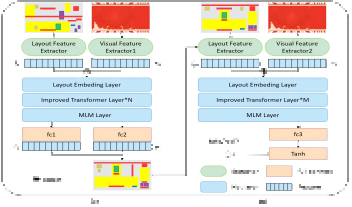
Layout design is an important step in packaging graphic design, and high-quality layout design is an important attribute to attract consumers’ attention and subsequent purchase. In order to solve the problems of time-consuming, difficult communication and strong dependency faced by manually performing package graphic design, we propose a template-free package layout generation method to achieve intelligent layout design. This method uses generative adversarial network (GAN) as a framework, and the generator and discriminator are composed of two improved transformer structures, which combines the advantages of two mainstream generative models, taking into account the rich layout variations in packaging design for generating a robust layout. We also constructed a packaging dataset PackageLayout to verify the superiority of the proposed method, which contains 2020 packaging planar images and annotation information for three categories. After ablation experiments on the homemade packaging dataset and comparison experiments with current state-of-the-art methods (CGLGAN, DSGAN), we validated the effectiveness and stability of the model. The layouts generated by our model are visually similar to the real design layouts and outperform previous models in terms of evaluation metrics. Finally, we also constructed real designs based on the predicted layouts to better understand the visual quality, which contributes to the advancement of the application of intelligent layout design models in packaging graphic design.

Accident detection is one of the biggest challenges as there are various anomalies, occlusions, and objects in the image at different times. Therefore, this paper focuses on detecting traffic accidents through a combination of Object Tracking (OT) and image generation using GAN with variants such as skip connection, residual, and attention connection. The background removal techniques will be applied to reduce the background variation in the frame. Later, YOLO-R is used to detect objects, followed by DeepSort tracking of objects in the frame. Finally, the distance error metric and the adversarial error are determined using the Kalman filter and the GAN approach and help to decide accidents in videos.

The high-resolution magnetic resonance image (MRI) provides detailed anatomical information critical for clinical application diagnosis. However, high-resolution MRI typically comes at the cost of long scan time, small spatial coverage, and low signal-to-noise ratio. The benefits of the convolutional neural network (CNN) can be applied to solve the super-resolution task to recover high-resolution generic images from low-resolution inputs. Additionally, recent studies have shown the potential to use the generative advertising network (GAN) to generate high-quality super-resolution MRIs using learned image priors. Moreover, existing approaches require paired MRI images as training data, which is difficult to obtain with existing datasets when the alignment between high and low-resolution images has to be implemented manually.This paper implements two different GAN-based models to handle the super-resolution: Enhanced super-resolution GAN (ESRGAN) and CycleGAN. Different from the generic model, the architecture of CycleGAN is modified to solve the super-resolution on unpaired MRI data, and the ESRGAN is implemented as a reference to compare GAN-based methods performance. The results of GAN-based models provide generated high-resolution images with rich textures compared to the ground-truth. Moreover, results from experiments are performed on both 3T and 7T MRI images in recovering different scales of resolution.

For forensic analysis of digital images or videos, the PRNU or camera fingerprint is the most important characteristics, for source attribution and manipulation localization. Typically, a good estimate of the PRNU is obtained by computing its Maximum Likelihood estimate from noise residuals of a large number of flatfield images captured by the camera. In this paper, we propose a novel approach of estimating the fingerprint of a camera, with a Generative Adversarial Network (GAN). The idea is to let the Generator network learn a distribution, from which PRNU samples will be drawn after training of the two adversarial networks. Experimental results indicate that the GAN-generated PRNU yields state-of-the-art camera identification and manipulation localization results.

A conditional general adversarial network (GAN) is proposed for image deblurring problem. It is tailored for image deblurring instead of just applying GAN on the deblurring problem. Motivated by that, dark channel prior is carefully picked to be incorporated into the loss function for network training. To make it more compatible with neuron networks, its original indifferentiable form is discarded and L2 norm is adopted instead. On both synthetic datasets and noisy natural images, the proposed network shows improved deblurring performance and robustness to image noise qualitatively and quantitatively. Additionally, compared to the existing end-to-end deblurring networks, our network structure is light-weight, which ensures less training and testing time.